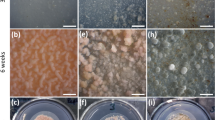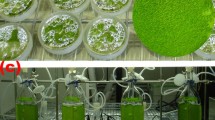Abstract
The presence of the tetracyclic diterpene 16α-hydroxykaurane (16α-hydroxy-ent-kaurane, C20H34O, CAS 5524–17–4) was detected in sterile cell cultures of the moss Physcomitrella patens (Hedw.) B.S.G. using gas chromatography and mass spectrometry. 16α-hydroxykaurane was found to be a major lipid compound in P. patens, with an estimated intracellular concentration of up to 0.84 mmol/l and an extracellular concentration of up to 9.3 µmol/l. The overall content of 16α-hydroxykaurane (in milligrams) produced per culture reached 0.37-fold that of chlorophyll a+b. In agar cultures with low air exchange, 16α-hydroxykaurane forms needle-like crystals on tissue and on the inner surface of the culture vessels, indicating that it is being released into the atmosphere. Solid phase microextraction confirmed the air-bound release of 16α-hydroxykaurane. To our knowledge this is the first report on the release of a plant-derived tetracyclic diterpene into the air.




Similar content being viewed by others
References
Amann J, Meylan C (1912) Flore des mousses de la suisse. Impremeries Reunies, Lausanne, vol 22
Asakawa Y (1995) Chemical constituents of the bryophytes. In: Herz W, Kirby GW, Moore RE, Steglich W, Tamm C (eds) Progress in the chemistry of organic natural products, vol 65. Springer, New York, pp 391–403
Ashton NW, Cove DJ (1977) The isolation and preliminary characterisation of auxotrophic and analogue resistant mutants of the moss, Physcomitrella patens. Mol Gen Genet 154:87–95
Briggs LH, Cain BF, Cambie RC, Davis BR, Rutledge PS, Wilmshurst JK (1963) Diterpenes-part 7. Kaurene. J Chem Soc 1345–1355
Cove D (2000) The moss, Physcomitrella patens. J Plant Regul 19:275–283
Cooper-Driver GA, Le Quesne PW (1987) Dipertenoids as insect antifeedants and growth inhibitors: role in Solidago species. In: Waller RG (ed) Allelochemicals: role in agriculture and forestry, American Chemical Society, Washington, pp 534–550
Egener T, Granado J, Guitton MC, Hohe A, Holtorf H, Lucht JM, Rensing S, Schlink K, Schulte J, Schween G, Zimmermann S, Duwenig E, Rak B, Reski R (2002) High frequency of phenotypic deviations in Physcomitrella patens plants transformed with a gene disruption library. BMC Plant Biol 2:6
Farmer EE (2001) Surface-to-air signals. Nature 411:854–856
Fujita E, Node M (1984) Diterpenoids of Rabdosia species. Progr Chem Org Nat Prod 46: 77–157
Hahn H, Bopp M (1968) A cytokinin test with high specificity. Planta 83:115–118
Hanson DT, Swanson S, Graham LE, Sharkey TD (1999) Evolutionary significance of isoprene emission from mosses. Am J Bot 86:634–639
Hugel G, Lods L, Mellor JM, Theobald DW, Ourisson G (1963) Structure de diterpenènes isolés de Trachylobium verrucosum. Bull Soc Chim Fr 1974–1976
Hunek S (1968) Lichen substances. In: Reinhold L, Liwschitz Y (eds) Progress in Phytochemistry, vol 1. Interscience, London, pp 260–261
IUPAC Recommendations (1999) http://www.chem.qmw.ac.uk/iupac/sectionF/RF10.html
Kalinowsky AI, Serebryakov EP, Zolotarev BM, Simolin AV, Kucherov VF, Chizhov OS (1970) Mass spectrometry of kaurene derivatives—1. the mass spectra of some (−)-Kauran-16-ols. Org Mass Spectrom 3:1393–1400
Kesselmeyer J, Staudt M (1999) Biogenic volatile organic compounds (VOC): an overview on emission, physiology and ecology. J Atmos Chem 33:23–88
Knight CD, Cove DJ, Boyd PJ, Ashton NW (1988) The isolation of biochemical and developmental mutants in Physcomitrella patens. In: Glime JM (ed) Methods in bryology. Proc Bryol Method Workshop. Mainz Hattori Bot Lab, Nichinan, pp 47–58
Le Quesne PW, Honkan V, Onan KD, Morrow PA, Tonkyn D (1985) Oxidized kaurane derivatives from leaves of Solidago missouriensis and S. rigida. Phytochemistry 24:1785–787
Le Quesne PW, Cooper-Driver GA, Villani M, Do MN, Morrow PA, Tonkyn DA (1986) Biologically active diterpenoids from Solidago species—plant insect interactions. In: Rahman A, Le Quesne PW (eds) New Trends Nat Prod Chem 26:271–282
Lehn J-M., Huneck S (1965) Die erstmalige Isolierung des Diterpens (−)-16-α-Hydroxykauran aus einer Flechte. Z Naturforschung 20b:1013
Lichtenthaler HK (1987) Chlorophylls and carotenoids: pigments of photosynthetic biomembranes. Method Enzymol 148:350–382
McGimpsey JR, Murray J (1960) Essential oils of New Zealand Podocarpaceae. II. Podocarpus spicatus. J Appl Chem 10:340–344
Mues R (2000) Chemical constituents and biochemistry. In: Shaw AJ, Goffinet B (eds) Bryophyte biology. Cambridge University Press, Cambridge, pp 150–181
Neuenschwander U, Fleming AJ, Kuhlemeier C (1994) Cytokinin induces the developmentally restricted synthesis of an extracellular protein in Physcomitrella patens. Plant J 5:21–31
Nilsson E, Martensson O (1971) Chemical studies on bryophytes—11. (−)-16-Hydroxykaurane from Saelania glaucescens (Hedw. ) Broth. Acta Chem Scand 25:1486–1487
Nishida K, Uota H (1931) Untersuchung über das ätherische Öl aus Podocarpus macrophylla, Don. Bull Agric Chem Soc Jpn:7: 1, 157, 957
Nishiyama TT, Fujita T, Shin IM, Seki H, Nishide I, Uchiyama A, Kamiya P, Carninci Y, Hayashizaki K, Shinozaki Y, Kohara M, Hasebe (2003) Comparative genomics of Physcomitrella patens gametophytic transcriptome and Arabidopsis thaliana: Implication for land plant evolution. Proc Natl Acad Sci USA 100:8007–8012
Nyholm E (1954) II. Musci. In: Swedish Natural Science Research Council, The Botanical Society of Lund (ed) Illustrated moss flora of Fennoscandia. Lund, Sweden
Perry NB, Burgress EJ, Baek S-H, Weavers RT, Geis W, Mauger A (1999) 11-Oxygenated cytotoxic 8,9-secokauranes from a New Zealand liverwort Lepidolaena taylorii. Phytochemistry 50: 423–433
Rensing SA, Rombauts S, Van de Peer Y, Reski R (2002) Moss transcriptome and beyond. Trends Plant Sci 7: 535–538
Reutter K, Atzorn R, Hadeler B, Schmülling T, Reski (1998) Expression of the bacterial ipt gene in Physcomitrella rescues mutations in budding and in plastid division. Planta 206:196–203
Schaefer DG (2002) A new moss genetics: targeted mutagenesis in Physcomitrella patens. Annu Rev Plant Biol 53:477–501
Schulz P, Reski R, Maldiney R, Laloue M, Schwartzenberg K v (2000) Kinetics of cytokinin production and bud formation in Physcomitrella: analysis of wild type, a developmental mutant and two of its ipt transgenics. J Plant Physiol 156:768–774
Schulz P, Hofmann A, Russo V, Hartmann E, Laloue M, Schwartzenberg K von (2001) Cytokinin overproducing ove mutants of Physcomitrella patens show increased riboside to base conversion. Plant Physiol 126:1224–1231
Schwartzenberg K von, Pethe C, Laloue M (2003) Cytokinin metabolism in Physcomitrella patens—differences and similarities to higher plants. Plant Growth Regul 39:99–106
Takahashi JA, Vieira HS, Boaventura MAD, Hanson JR, Hitchcock PB, de Oliveira AB (2001) Mono and diterpenes from seeds of Xylopia sericea. Quim Nova 24:616–618
Tori M, Arbyiyanti H, Taira Z, Asakawa Y (1993) Terpenoids of the liverwort Frullanoides densifolia and Tricholejeunea sandvicensis. Phytochemistry 32:335–348
Wang TL, Horgan R, Cove D (1981) Cytokinins from the moss Physcomitrella patens. Plant Physiol 68:735–738
Acknowledgements
We thank Hanco Mierendorff (Inst. für Pharmazie, Hamburg) for help with the automatic GC sample processing. We thank Karen Dehn for the scanning electron micrographs, Hanna Blaschke and Naemi Grau for skilful laboratory work. We further thank Heribert Köckinger (Weissenkirchen, Austria) for Saelania glaucescens samples from the Austrian alps and Barbara Moffatt (University of Waterloo, Canada) for critically reading the manuscript. K.v.S. acknowledges funding by the Deutsche Forschungsgemeinschaft.
Author information
Authors and Affiliations
Corresponding author
Additional information
Communicated by R. Reski
This work is dedicated to the 65th birthday of Prof. Heinz Hahn.
Electronic Supplementary Material
Rights and permissions
About this article
Cite this article
von Schwartzenberg, K., Schultze, W. & Kassner, H. The moss Physcomitrella patens releases a tetracyclic diterpene. Plant Cell Rep 22, 780–786 (2004). https://doi.org/10.1007/s00299-004-0754-6
Received:
Revised:
Accepted:
Published:
Issue Date:
DOI: https://doi.org/10.1007/s00299-004-0754-6




